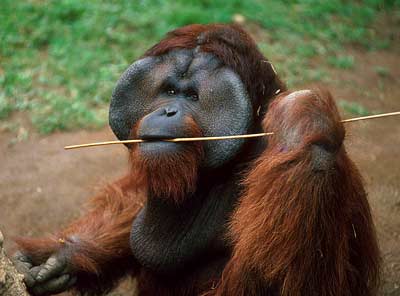
Thanks to Geraldine F and Zoran A for the link
from WIRED.com
By Olivia Solon
A team of anthropologists have shown that orangutans may have the ability to learn socially and pass these lessons down through generations — evidence that culture in humans and great apes has the same evolutionary roots.
In humans, certain behavioral innovations tend to be passed down from generation to generation through social learning. Many consider the existence of culture in humans to be one of the key factors that differentiates us from other animals.
Around a decade ago, biologists observing great apes noticed geographical variations in behavior that suggested that they were passing certain innovations down through generations, just as humans do. To this day, there is much debate about whether geographical variations in behavior is driven culturally or through genetic and environmental factors.
Researchers from the University of Zurich have now studied whether the geographic variation of behavioral patterns in nine orangutan populations in Sumatra and Borneo can be explained by cultural transmission. They have concluded that it can.
The team analyzed more than 100,000 hours of behavioral data and created genetic profiles of more than 150 wild orangutans. They measured the ecological differences between the habitats of the different populations using satellite imagery and remote sensing techniques.
Co-author of the study, published in Current Biology, Carel van Schaik said: “The novelty of our study is that, thanks to the unprecedented size of our dataset, we were the first to gauge the influence genetics and environmental factors have on the different behavioral patterns among the orangutan populations.”
Environmental influences and, to a lesser degree, genetic factors did play an important role in defining differences in social structure and behavioral ecology between the populations. However, these factors did not explain the behavioral patterns.
Michael Krützen, the first author of the study, said: “The cultural interpretation of the behavioral diversity also holds for orangutans — and in exactly the same way as we would expect for human culture. It looks as if the ability to act culturally is dictated by the long life expectancy of apes and the necessity to be able to adapt to changing environmental conditions.”







No comments:
Post a Comment